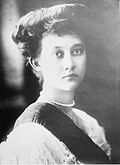House of Nassau-Weilburg
Under the 1783 Nassau Family Pact, those territories of the Nassau family in the Holy Roman Empire at the time of the pact (Luxembourg and Nassau) were bound by semi-Salic law, which allowed inheritance by females or through the female line only upon extinction of male members of the dynasty. When William III died leaving only his daughter Wilhelmina as an heir in 1890, the crown of the Netherlands, not being bound by the family pact, passed to Wilhelmina. However, the crown of Luxembourg passed to a male of another branch of the House of Nassau: Adolphe, the dispossessed Duke of Nassau and head of the branch of Nassau-Weilburg.
In 1905, Grand Duke Adolphe's younger half-brother, Prince Nikolaus Wilhelm of Nassau, died, having left a son Georg Nikolaus, Count von Merenberg who was, however, the product of a morganatic marriage, and therefore not legally a member of the House of Nassau. In 1907, Adolphe's only son, William IV, Grand Duke of Luxembourg, obtained passage of a law confirming the right of his eldest daughter, Marie-Adélaïde, to succeed to the throne in virtue of the absence of any remaining dynastic males of the House of Nassau, as originally stipulated in the Nassau Family Pact. She became the grand duchy's first reigning female monarch upon her father's death in 1912, and upon her own abdication in 1919 was succeeded by her younger sister Charlotte, who married Felix of Bourbon-Parma, a prince of the former Duchy of Parma. Charlotte's descendants have since reigned as the continued dynasty of Nassau.
| Portrait | Name | Lifespan | Reign start | Reign end | Titles | Claim |
|---|
 | Adolphe | 24 July 1817 –
17 November 1905
(88 years) | 23 November 1890 | 17 November 1905 | Grand Duke of Luxembourg;
Duke of Nassau | Third cousin of Guillaume III |
 | Guillaume IV | 22 April 1852 –
25 February 1912
(59 years) | 17 November 1905 | 25 February 1912 | Son of Adolphe |
 | Marie-Adélaïde | 14 June 1894 –
24 January 1924
(29 years) | 25 February 1912 | 14 January 1919
(abdicated) | Grand Duchess of Luxembourg;
Duchess of Nassau | Daughter of Guillaume IV |
 | Charlotte | 23 January 1896 –
9 July 1985
(89 years) | 14 January 1919 | 12 November 1964
(abdicated) | Daughter of Guillaume IV
Sister of Marie-Adélaïde |















